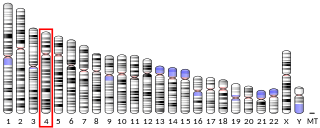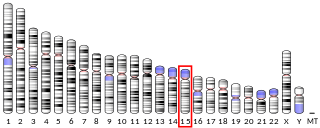
TSR3, or TSR3 Ribosome Maturation Factor, is a hypothetical human protein found on chromosome 16. Its protein is 312 amino acids long and its cDNA has 1214 base pairs. It was previously designated C16orf42.

C9orf64 is a gene located on chromosome 9, that in humans encodes the protein queuosine salvage protein. The function and biological process of the queuosine salvage protein is a queuosine-nucleotide N-glycosylase/hydrolase (QNG1) that releases queuine from Q-5'-monophosphate, and this activity is required for the salvage of queuine from exogenous Queuosine by S. pombe and HeLa cells. Some evidence from orthologs indicates it may be involved in tRNA processing and recycling. The most common mRNA contains 4 coding exons, and it has 2 additional alternatively spliced exons. C9orf64 has been found in 5 different splice variants.

Transmembrane protein 151B is a protein that in humans is encoded by the TMEM151B gene.

Ankyrin repeat domain-containing protein 24 is a protein in humans that is coded for by the ANKRD24 gene. The gene is also known as KIAA1981. The protein's function in humans is currently unknown. ANKRD24 is in the protein family that contains ankyrin-repeat domains.

Transmembrane and coiled-coil domains 4, TMCO4, is a protein in humans that is encoded by the TMCO4 gene. Currently, its function is not well defined. It is transmembrane protein that is predicted to cross the endoplasmic reticulum membrane three times. TMCO4 interacts with other proteins known to play a role in cancer development, hinting at a possible role in the disease of cancer.

Cilia and flagella associated protein 157 (CFAP157) also known as chromosome 9 open reading frame 117 (c9orf117) is a protein that in humans is encoded by the CFAP157 gene.

Transmembrane protein 44 is a protein that in humans is encoded by the TMEM44 gene.

Chromosome 19 open reading frame 44 is a protein that in humans is encoded by the C19orf44 gene. C19orf44 is an uncharacterized protein with an unknown function in humans. C19orf44 is non-limiting implying that the protein exists in other species besides human. The protein contains one domain of unknown function (DUF) that is highly conserved throughout its orthologs. This protein is most highly expressed in the testis and ovary, but also has significant expression in the thyroid and parathyroid. Other names for this protein include: LOC84167.

Cilia- and flagella-associated protein 299 (CFAP299) is a protein that in humans is encoded by the CFAP299 gene. CFAP299 is predicted to play a role in spermatogenesis and cell apoptosis.

Single-pass membrane and coiled-coil domain-containing protein 3 is a protein that is encoded in humans by the SMCO3 gene.

C1orf122 is a gene in the human genome that encodes the cytosolic protein ALAESM.. ALAESM is present in all tissue cells and highly up-regulated in the brain, spinal cord, adrenal gland and kidney. This gene can be expressed up to 2.5 times the average gene in its highly expressed tissues. Although the function of C1orf122 is unknown, it is predicted to be used for mitochondria localization.

The FAM214B, also known as protein family with sequence similarity 214, B (FAM214B) is a protein that, in humans, is encoded by the FAM214B gene located on the human chromosome 9. The protein has 538 amino acids. The gene contain 9 exon. There has been studies that there are low expression of this gene in patients with major depression disorder. In most organisms such as mammals, amphibians, reptiles, and birds, there are high levels of gene expression in the bone marrow and blood. For humans in fetal development, FAM214B is mostly expressed in the brains and bone marrow.

C11orf98 is a protein-encoding gene on chromosome 11 in humans of unknown function. It is otherwise known as c11orf48. The gene spans the chromosomal locus from 62,662,817-62,665,210. There are 4 exons. It spans across 2,394 base pairs of DNA and produces an mRNA that is 646 base pairs long.

Chromosome 12 Open Reading Frame 50 (C12orf50) is a protein-encoding gene which in humans encodes for the C12orf50 protein. The accession id for this gene is NM_152589. The location of C12orf50 is 12q21.32. It covers 55.42 kb, from 88429231 to 88373811, on the reverse strand. Some of the neighboring genes to C12orf50 are RPS4XP15, LOC107984542, and C12orf29. RPS4XP15 is upstream C12orf50 and is on the same strand. LOC107984542 and C12orf29 are both downstream. LOC107984542 is on the opposite strand while C12orf29 is on the same strand. C12orf50 has six isoforms. This page is focusing on isoform X1. C12orf50 isoform X1 is 1711 nucleotides long and has a protein with a length of 414 aa.

C4orf36 is a protein that in humans is encoded by the c4orf36 gene.

NADP-dependent oxidoreductase domain-containing protein 1 is a protein that in humans is encoded by the NOXRED1 gene. An alias of this gene is Chromosome 14 Open Reading Frame 148 (c14orf148). This gene is located on chromosome 14, at 14q24.3. NOXRED1 is predicted to be involved in pyrroline-5-carboxylate reductase activity as part of the L-proline biosynthetic pathway. It is expressed in a wide variety of tissues at a relatively low level, including the testes, thyroid, skin, small intestine, brain, kidney, colon, and more.

Chromosome 5 Open Reading Frame 47, or C5ORF47, is a protein which, in humans, is encoded by the C5ORF47 gene. It also goes by the alias LOC133491. The human C5ORF47 gene is primarily expressed in the testis.

DENN/MADD domain containing 2C (DENND2C) is a protein that in humans is encoded by the DENND2C gene.

Transmembrane 202 protein is encoded by the gene TMEM202 and is a member of the Claudin2 superfamily. Human paralogs include LIMP2, GSG1, CLDND2, NKG7. The specific function of TMEM202 has largely yet to be elucidated, but other Claudin2 superfamily proteins plays important roles in paracellular transport by contributing to the structure of gap junctions. In S. scrofa, TMEM202 has been found to aid in sperm motility, fertilization, and spermatogenesis.

Chromosome 13 open reading frame 16 is a protein in homo sapiens encoded by the C13orf16 gene. There is one alias name, TEX29, for the high testis expression of this gene due to spermatogenesis.


















